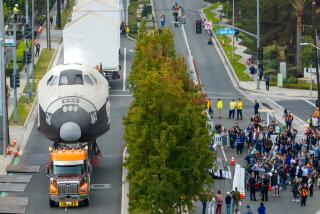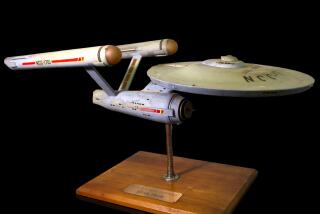Trash Landing : History: Smithsonian claims shuttle engine mock-ups are at museum, but Rockwell says they were unceremoniously dumped in a landfill.
- Share via
PALMDALE — Depending on whom you believe, an important part of this country’s space exploration history is either in the Smithsonian Institution or decaying in the hot sun in a Palmdale landfill.
Space shuttle builder Rockwell International says that more than a decade ago it sent to the dump a set of shuttle engine mock-ups that were used as part of the test program for the Enterprise--the first orbiter ever built.
But what Rockwell said it disposed of at the dump are the same exact things the National Air and Space Museum in Washington believes it has in its collection. The museum says the shuttle engine nozzles are attached to the back of the Enterprise, a non-flying orbiter used for testing in the late 1970s that was donated by NASA to the museum in 1985.
The mock-ups were used in approach and landing tests that included putting Enterprise atop a modified 747 and releasing it 26,000 feet above the expansive dry lake beds at Edwards Air Force Base to see if it could, in fact, glide to an unpowered landing.
Rockwell officials said just one set of the mock-ups was built and they are the ones at the dump.
“If the real approach and landing nozzles are out there in California, then what do we have?” asked Valerie Neal, a curator for the museum’s department of space history.
Fred Valentino, who has been general manager of the Palmdale dump for nearly two decades, said the three shuttle engine nozzles, which were designed to simulate the size, shape and weight of the real space shuttle main engines, arrived at the landfill several years ago during the town’s annual cleanup week.
Rockwell, which builds the space shuttles at its facility at Air Force Plant 42 in Palmdale, no longer had a use for the nozzles and so, with the blessing of the government, disposed of them.
“Rather than storing them, because they have no functional value or purpose down the line, Rockwell and NASA property managers decided to dispose of them,” said Alan Buis, a spokesman for Rockwell Space Systems Division. “That’s how they ended up where they currently are.”
But museum curator Neal is confident Rockwell must be mistaken about the mock-ups it sent to the dump.
“I talked to a couple people who were here when Enterprise was delivered,” she said. “We were never notified that anything on Enterprise was not part of the test configuration.”
But if Rockwell is right, historians and museum curators fear that a piece of history is weathering in the desert sun, in a dump, no less.
“That is disturbing,” said Derek Elliott, who was curator of the Air and Space Museum’s manned space collection at the time Enterprise arrived. Elliott is now a history professor at Tennessee State University in Nashville.
Elliott said that when Enterprise was given to the museum, no one thought to ask if the nozzles were the ones used in the tests at Edwards Air Force Base. It was just assumed they were.
Through an agreement between NASA and the Smithsonian, NASA is supposed to offer anything considered a potential artifact to the museum before discarding it. Elliott said it is possible that when the nozzles were dumped, the process broke down or NASA didn’t realize their historical value.
“Even if we didn’t acquire them, I can almost guarantee some other space history museum or center would be interested in something like that,” Elliott said. “It’s part of this nation’s history, the history of the space shuttle.”
But, Elliott said, items that historians and curators believe significant are not always judged as such by others.
James Hartsfield, NASA shuttle program spokesman at the Johnson Space Center in Texas, said, “It’s not unique that you found engine mock-ups in a dump in California.”
He said various junked mock-ups from the Apollo program can be found at landfills near the Kennedy Space Center in Florida.
Meanwhile, Palmdale landfill manager Valentino isn’t all that eager to give up what he sees as his piece of space history.
Although he’s never been sure exactly what they are, he has kept the mock-ups from being buried under tons of grass clippings, tin cans and used tires. They sit near an old, discarded dinghy and appear to be used as a resting place and toilet facility for the many dump-scavenging birds that frequent the landfill.
It may not be the Smithsonian, but eventually, Valentino says he’s going to put the three engine nozzles on display and show them during tours.
More to Read
Sign up for Essential California
The most important California stories and recommendations in your inbox every morning.
You may occasionally receive promotional content from the Los Angeles Times.










